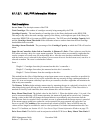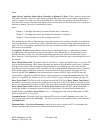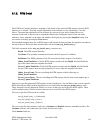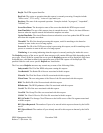alarm.
Same Job on Controller, Other Job on Controller, & Distance To Drive. These values are used by the
PVR when selecting a drive for a tape mount operation. The three values are essentially weights that are
used to compute an overall score for each possible drive. After the score has been calculated, the drive
with the lowest score is selected for the mount. If two or more drives tie for the lowest score, one drive is
selected at random. The score is calculated as follows:
Score =
Weight 1 * Cartridges from this job mounted on this drive’s controller +
Weight 2 * Cartridges from other jobs mounted on this drive’s controller +
Weight 3 * Units of distance from the cartridge to the drive
This method has the effect of distributing a striped tape mount across as many controllers as possible for
the best performance. It also will try to pick controllers that are currently driving a minimum number of
tapes. So, in an environment with many tape drives per controller, the above algorithm will minimize the
load on any one controller.
The Distance To Drive helps minimize mount times by mounting the tape in a physically close drive.
For IBM robots, the time it takes to move a cartridge to a more distant drive is not significant, so the
default value here is fairly low. All other things being equal, the tape will be mounted in the closest
drive. However, if the closest drive is attached to a heavily used controller, then a more distant drive will
be selected.
Retry Mount Time Limit. The default value for this field is -1. When the default value (-1) is used, if an
error is encountered during a PVR mount operation, the mount will pend and be retried every 5 minutes.
Setting a value in this field will change the mount behavior to periodically retry the mount until the
specified time limit is exceeded. Once exceeded, an error is generated and the mount request is canceled.
If the mount request would have resulted in a write operation, the error returned will cause the Core
Server to set the VV Condition of the associated tape volume to DOWN. Once in DOWN state, the
volume will no longer be available for read or write operations. For further information about the Core
Server VV Condition, see Section 4.5.4.2: Core Server Tape Volume Information Window on page 271.
Drive Error Limit. This field is used in conjunction with the PVR Server Retry Mount Time Limit. If
the number of consecutive mount errors which occur to any drive in this PVR equal or exceed this value,
the drive is automatically locked by the PVL. The only mount errors that apply are those set through the
Retry Mount Time Limit mechanism. The Drive Error Count field in the PVL Drive Information
records the number of consecutive errors on a drive by drive basis. To turn off the automatic drive
disable feature, set the Drive Error Limit to 0 or -1. Changing this value will not change drive disable
behavior until the PVL is recycled.
Command Device. The name of the device that the PVR can use to send commands to the robot. For
AIX systems, this is generally /dev/smc0. For Linux systems, use the symbolic library name defined in
/etc/ibmatl.conf.
Dismount Delay. When Defer Dismounts is checked, this value is used by the PVL to determine the
number of minutes that dismounts are delayed after the last data access.
HPSS Management Guide November 2009
Release 7.3 (Revision 1.0) 140


















